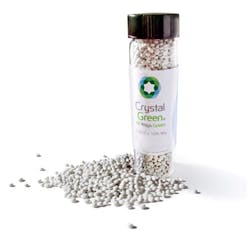Nutrient Recovery 2.0
A number of nutrient recovery installations have come online in 2016, with more than 20 installations now worldwide. Next generation technology is allowing for the recovery of carbon, phosphorus and nitrogen but are regulations keeping up?
By Dr. Christian Kabbe
The year 2016 can be considered a good year for nutrient recovery from the wastewater path. Several new struvite recovery installations have been commissioned and new implementation projects have be launched. Besides the 1st generation recovery units, a number of advanced, so-called 2nd generation units have started operation as well. Also the focus on phosphorus known from the recent years has been broadened towards another precious element of life - nitrogen.
Although nitrogen is not considered a scarce resource, it’s transformation from elemental nitrogen into reactive nitrogen for anthropogenic use by the Haber-Bosch process is highly energy intensive and therefore highly relevant for the whole climate change issue. The smart combination of proven technology modules at wastewater treatment plants (WWTPs) enables synergies to be tapped between enhanced carbon, phosphorus and nitrogen recovery.
Technology progress
The world’s first combination of Ostara Nutrient Recovery Technologies’s WASSTRIP and PEARL with LYSOTHERM in Amersfoort (NL, Waterboard Vallei en Veluwe) is one good example of 2nd generation nutrient recovery with enhanced carbon management. The operational benefits such as improved biodegradation and increased biogas yield, the increased ortho-P concentration in the aqueous phase providing higher recovery rates and the reduced sludge solids to be disposed are strong arguments for implementation at WWTPs with enhanced biological phosphorus removals and anaerobic digestion. The operational cost can be reduced by several hundreds of thousands euros per year, even without selling the struvite. Ostara’s second WASSTRIP and PEARL combination in Europe just started operation in Madrid.
A similar project is currently underway in Brunswick, Germany, with the tendering closing in September 2016. At WWTP Steinhof (Abwasserverband Braunschweig AVB, SE|BS), the combination of thermal hydrolysis for enhanced sludge disintegration, struvite recovery and ammonia stripping will be the first full-scale carbon, phosphorus and nitrogen recovery facility in Europe. The recovered struvite and ammonium sulfate will be valorised locally.
Although struvite recovery is already both technically and economically feasible, the market potential is limited to WWTPs having enough dissolved phosphorus in the sludge water. This is mainly the case for a treatment plant with enhanced biological phosphorus removal and anaerobic digestion (AD). Since the number of these WWTPs is quite limited in comparison to phosphorus removal by chemical precipitation with iron or aluminium salts, other options have to be considered as well.
A zero waste approach
Since acid leaching of digested sludge on-site WWTP turned out to be too expensive mainly due to chemicals consumption, sludge leaching cannot be expected a promising way to go. An alternative technology has been developed by the chemical company Budenheim - the EXTRAPHOS process. Here, the phosphorus extraction from the digested sludge is done with CO2 under pressure. The dissolved phosphate is then recovered as Dicalciumphosphate (DCP) a commercial product. The CO2 is intended to be recycled internally.
Bench scale tests allowed recovery rates around 50% but Budenheim targets 70%. A pilot installation at a WWTP in Mainz (Germany) will allow the necessary optimisation for upscaling. There are already concrete plans for a large scale demonstration in Itzehoe (Northern Germany) in cooperation with cement works, valorizing the phosphorus depleted sludge solids. The whole approach enables a zero waste scenario, whereas most leaching processes produce acidic filter cakes and related problems in terms of disposal.
In countries with dedicated sludge incineration capacity, the undiluted sewage sludge ash (SSA) presents the highest phosphorus concentrate obtained from the wastewater path. It should be noted that besides phosphorus, non-volatile heavy metals are also concentrated during incineration as well, the ashes are considered with suspicion. Based on the excellent SSA monitoring conducted by Germany’s Federal Institute for Materials Research and Testing (BAM) and financed by the German EPA in 2013/2014, we know that only a few ashes from certain mono-incinerators meet the requirements set by the fertiliser regulation.
Further treatment of these ashes is necessary to improve the plant-availability of the phosphorus, but also to separate the phosphorus from the contaminants like heavy metals.
The use of these ashes as part substitute for fossil phosphorus rock in conventional fertiliser production could be one option. Companies like ICL Fertilizers already successfully tested several phosphorus rich ashes for their substitution potential. Meat and bone meal ashes appeared to be the most promising due to their homogeneity, high phosphorus content and low contaminants levels. For SSA, the results were more heterogeneous and the substitution potential is, besides a sufficient phosphorus content strongly dependent on the Fe/Al content.
Besides technical issues, also legal aspects are rather hampering this route of recycling instead of promoting it. Today, only ashes can be used for fertiliser production, being already compliant to the quality requirements of fertiliser products. It appears not to be logic to ask for end-product qualities in the case of raw materials.
Technical alternatives
Therefore, other technical options and business models have been developed to recover phosphorus from ashes. A prominent example is the ECOPHOS process, extracting phosphorus from ash by acid attack and separating the heavy metals from the phosphorus. This yields technical phosphoric acid (H3PO4) or DCP, both commercial products. Besides that, metals salts can be obtained applicable at WWTP for chemical phosphorus removal. A large scale facility has been commissioned in Varna, Bulgaria where besides low grade phosphorus rock other similar materials can be processed and tested.
Interested ash suppliers can book trial projects there to see, what can be done with their ashes. A full-scale plant is currently under construction in Dunkerque, France. ECOPHOS and the two biggest Dutch mono-incinerators already signed a contract last year for 60,000 t SSA/a to be treated there in the near future.
A similar approach has been followed by Remondis when developing the TetraPhos process. A pilot is running since 2015 in Hamburg with the intention for the plant to be upscaled. BAM and Outotec are further developing the Ash Dec process with promising results regarding the product quality. Furthermore, the MEPHREC (metallurgical P recovery) pilot, yielding a phosphorus rich slag is currently in commissioning in Nuremburg, Germany. If the results meet expectations, a full-scale plant will be set-up on the same site. More and more companies are now following these examples and there is a strong tendency for most of them to yield technical phosphoric acid.
One exclusion has been developed in the EU funded project RecoPhos, the thermal-reductive conversion of phosphates from ashes into white phosphorus (P4). The patent has been bought by ICL from SGL Carbon in spring this year. ICL’s ambition is to further mature the technology and to upscale it in the coming two years. If they succeed, ICL will set-up four modules in Europe and two in the US. Each module will then process 100 kt ash into 9 kt P4. So, four modules would be able to process the full quantity of SSA produced in Germany.
Legal framework and aspects
Despite these developments, it raises the question of what good is nutrient recovery if the nutrients cannot be recycled back into the food chain? The current legal framework is rather discriminating against recovered nutrients from waste, which is unlikely to promote the closing of the nutrient cycle. This affects not only at a national level for member states but also a European level. Luckily, there are some encouraging developments here.
Within the European Commission’s circular economy package, the revision of the fertiliser regulation (2003/2003/EC) is one of the concrete examples heading forward towards an enabling framework for a circular economy for nutrients. The European Commission’s Directorate-General for Internal Market, Industry, Entrepreneurship and SMEs (DG GROW), with the assistance of the Joint Research Centre of the European Commission (DG JRC), has set up the Technical Working Group for the development of possible process and product criteria for struvite, biochar and ash-based products for use in fertilising products (STRUBIAS TWG). A first draft proposal is announced for May 2017. The intended deadline for the “hard” recommendations is set in 2018.
The explicit inclusion of struvite and other suitable recyclates will hopefully create the necessary level-playing-field for both, fossil based, and secondary materials based nutrients we are still lacking today. As it turned out over the year, many legislators are now waiting for the new fertiliser regulation to come, before they will react accordingly. This also includes DG AGRI, responsible for the fertiliser regulation for organic farming (889/2008/EC). The Expert Group for Technical Advice on Organic Production (EGTOP) has already recommended struvite and ASH DEC calcined phosphates for use in Organic Farming, where phosphate rock with it’s very limited fertilising efficiency is the only allowed mineral phosphorus source today.
So, readers are encouraged to contact their national phosphorus platforms to provide relevant input for the definition of quality requirements and end-of-waste criteria for the substances mentioned above.
Besides that, the EIP action group ARREAU launched a Struvite Recovery & Recycling Learning Alliance (SRRLA) last June in Amersfoort. The scope of this learning alliance is to facilitate the exchange between operators of struvite recovery and to compile and exchange all relevant information regarding struvite recovery itself but also regarding the valorization and marketing of struvite. REACH and approval of struvite for organic farming are only two points on the agenda. The strong link with the European Sustainable Phosphorus Platform (ESPP) enables an efficient coordination of all these activities.
Some European countries have implemented national regulation to promote phosphorus recovery from the wastewater path and other relevant, phosphorus rich waste streams. A new waste regulation entered into force in January 2016 in Switzerland, making phosphorus recovery from sewage sludge and meat and bone meal obligatory within a 10 year transition phase. In Germany, the new draft of the sewage sludge ordinance has been agreed between the different ministries and is now out in Brussels for notification. It may enter into force with a date 1st January 2018 making phosphorus recovery from sewage sludge obligatory for all German WWTP larger than 50,000 person equivalents (~500 WWTP). They will have to recover the phosphorus if the sludge contains more than 2% phosphorus /DS (dry solids) or have to incinerate the sludge in mono-incinerators. Land application of sludge will only be allowed for WWTP < 50,000 p.e..
In any case, the ashes are not suitable to be valorized, they have to be stored separately and recoverable in interim storages. The transition phase for WWTPs > 100,000 p.e. will be 12 years and for WWTP between 100,000 and 50,000 p.e. 15 years. Other countries have announced phosphorus recovery and recycling targets for the wastewater stream yet haven’t detailed concrete measures or techniques.
Outlook
Looking at technologies, struvite recovery represents the lowest hanging fruit in nutrient recovery and can be considered state-of-the-art. There are already more than 20 installation worldwide and more will come in the next years. The ~ 10,000 tonnes/annum of struvite currently produced in Europe are likely to double in the coming five years. This will be triggered not only be the number of new facilities but also by evolutionary reasons. Next generation nutrient recovery will combine enhanced carbon, phosphorus and nitrogen recovery and increase recovery rates by tapping synergies, making them even more beneficial for operators.
The biggest capture regarding phosphorus will be from sludge solids. There will be some installations onsite at WWTPs, extracting phosphorus from sludge solids but benefits for the operators will be limited. In countries with mono-incineration infrastructure, phosphorus recovery from ash will be the main route.
The legal framework, still rather hampering nutrient recycling will have to be adapted into an innovation and market facilitator. Whereas the technologies for nutrient recovery are already there, the product valorization is the most challenging task for the near future. Instead of the old way, recyclates have to be as good as current products on the market and we have to emphasize their improved properties. For example, various recyclates such as struvite are better compared to fossil-based phosphorus fertilisers when seen under sustainability and fertilising efficiency aspects. So, why in there the continuation to follow old dogmas instead of advancing fertilisers towards a next generation? Think forward, act circular!
Dr. Christian Kabbe is from the Berlin Centre of Competence for Water, Germany. For more information, email: [email protected].
More Water & WasteWater International Archives Issue Articles




